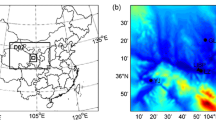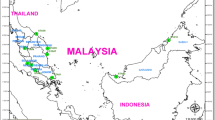Abstract
In recent years, a significant part of the studies on air pollutants has been devoted to improve statistical techniques for forecasting the values of their concentrations in the atmosphere. Reliable predictions of pollutant trends are essential not only for setting up preventive measures able to avoid risks for human health but also for helping stakeholders to take decision about traffic limitations. In this paper, we present an operating procedure, including both pollutant concentration measurements (CO, SO2, NO2, O3, PM10) and meteorological parameters (hourly data of atmospheric pressure, relative humidity, wind speed), which improves the simple use of neural network for the prediction of pollutant concentration trends by means of the integration of multivariate statistical analysis. In particular, we used principal component analysis in order to define an unconstrained mix of variables able to improve the performance of the model. The developed procedure is particularly suitable for characterizing the investigated phenomena at a local scale.

Similar content being viewed by others
References
Abbot, J., & Marohasy, J. (2014). Input selection and optimisation for monthly rainfall forecasting in Queensland, Australia, using artificial neural networks. Atmospheric Research, 138, 166–178.
Al-Alawi, S. M., Sabah, A., Wahab, A., & Bakheit, C. S. (2008). Combining principal component regression and artificial neural networks for more accurate predictions of ground-level ozone. Environmental Modelling and Software, 23, 396–403.
Antanasijević, D. Z., Pocajt, V. V., Povrenović, D. S., Ristić, M. D., & Perić-Grujić, A. A. (2013). PM10 emission forecasting using artificial neural networks and genetic algorithm input variable optimization. The Science of the Total Environment, 443, 511–519.
Atakan, K., & Betül, O. A. (2010). Forecasting air pollution indicator levels with geographic models 3 days in advance using neural network. Expert Systems With Applications, 37, 7986–7992.
Büns, C., Klemm, O., Wurzler, S., Hebbinghaus, H., Steckelbach, I., Friesel, J., Ebel, A., Friese, E., Jakobs, H., & Memmesheimer, M. (2012). Comparison of four years of air pollution data with a mesoscale model. Atmospheric Research, 118, 404–417.
Carnevale, C., Finzi, G., Pisoni, E., & Volta, M. (2009). Neuro-fuzzy and neural network system for air quality control. Atmospheric Environment, 31, 4811–4821.
Chelani, A. B. (2010). Prediction of daily maximum ground ozone concentration using support vector machine. Environmental Monitoring and Assessment, 162, 169–176.
Chelani, A. B., & Devotta, S. (2006). Air quality forecasting using a hybrid autoregressive and nonlinear model. Atmospheric Environment, 40, 1774–1780.
Chuang, M.-T., Zhang, Y., & Kang, D. (2011). Application of WRF/Chem-MADRID for real time air quality forecasting over the Southeastern United States. Atmospheric Environment, 45, 6241–6250.
Fernando, H. H. S., Mammarella, M. C., Grandoni, G., Fedele, P., Di Marco, R., Dimitrova, R., & Hyde, P. (2012). Forecasting PM10 in metropolitan areas: efficacy of neural networks. Environmental Pollution, 163, 62–67.
Genc, D. D., Yesilyurt, C., & Tuncel, G. (2010). Air pollution forecasting in Ankara, Turkey using air pollution index and its relation to assimilative capacity of the atmosphere. Environmental Monitoring and Assessment, 166, 11–27.
Gvozdić, V., Kovač-Andrić, E., & Brana, J. (2011). Influence of meteorological factors NO2, SO2, CO and PM10 on the concentration of O3 in the urban atmosphere of Eastern Croatia. Environmental Monitoring and Assessment, 16, 491–501.
Islam, T., Srivastava, P.K, Rico-Ramirez, M.A., Dai Q., Han, D., Gupta, M. (2014). An exploratory investigation of an adaptive neuro fuzzy inference system (ANFIS) for estimating hydrometeors from TRMM/TMI in synergy with TRMM/PR. Atmospheric Research, 145–146, 57–68.
Jacovides, C.P., Tymvios, F.S., Boland, J., Tsitouri, M. (2013). Artificial Neural Network models for estimating daily solar global UV, PAR and broadband radiant fluxes in an eastern Mediterranean site. Atmospheric Research, in press.
Kumar, A., & Goyal, P. (2011). Forecasting of daily air quality index in Delhi. Science of the Total Environment, 409, 5517–5523.
Kumar, U., & Jain, V. K. (2010). ARIMA forecasting of ambient air pollutants (O3, NO, NO2 and CO). Stochastic Environmental Research and Risk Assessment, 24, 751–760.
Li, C., Hsu, N. C., & Tsay, S.-C. (2011). A study on the potential application od satellite data in air quality monitoring and forecasting. Atmospheric Environment, 45, 3663–3675.
Lin, K.-P., Pai, P.-F., & Yang, S.-L. (2011). Forecasting concentrations of air pollutants by logarithm support vector regression with immune algorithms. Applied Mathematics and Computation, 217, 5318–5327.
Lu, T., & Viljanen, M. (2009). Prediction of indoor temperature and relative humidity using neural network models: model comparison. Neural Computing and Applications, 18, 345–357.
Lu, W.-Z., He, H., & Leung, A. Y. T. (2011). Assessing air quality in Hong Kong: a proposed revised air pollution index (API). Building and Environment, 46, 2562–2569.
Nastos, P. T., Moustris, K. P., Larissi, I. K., & Paliatsos, A. G. (2013). Rain intensity forecast using artificial neural networks in Athens, Greece. Atmospheric Research, 119, 153–160.
Paschalidou, A. K., Karakitsios, S., Kleanthous, S., & Kassomenes, P. (2011). Forecasting hourly PM10 concentration in Cyprus through artificial neural networks and multiple regression models: implications to local environmental management. Environmental Science and Pollution Research, 18, 316–327.
Perez, P. (2012). Combined model for PM10 forecasting in a large city. Atmospheric Environment, 60, 271–276.
Pires, J. C. M., Sousa, S. I. V., Pereira, M. C., Alvim-Ferraz, M. C. M., & Martins, F. G. (2008). Management of air quality monitoring using principal component and cluster analysis ¨C part I: SO2 and PM10. Atmospheric Environment, 42(6), 1249–1260.
Pires, J. C. M., Pereira, M. C., Alvim-Ferraz, M. C. M., & Martins, F. G. (2009). Identification of redundant air quality measurements through the use of principal component analysis. Atmospheric Environment, 43, 3837–3842.
Pisoni, E., Farina, M., Carnevale, C., & Piroddi, L. (2009). Forecasting peak air pollution levels using NARX models. Engineering Applications of Artificial Intelligence, 22, 593–602.
Priem, H. N. A. (2013). Climate change and carbon dioxide: geological perspective (review). Energy and Environment, 24, 361–380.
Querol, X., Alastuey, A., Pandolfi, M., Reche, C., Pérez, N., Minguillón, M. C., Moreno, T., Viana, M., Escudero, M., Orio, A., Pallarés, M., & Reina, F. (2014). 2001–2012 trends on air quality in Spain. Science of the Total Environment, 490, 957–969.
Ragosta, M., Caggiano, R., D’Emilio, M., Sabia, S., Trippetta, S., & Macchiato, M. (2006). PM10 and heavy metal measurements in an industrial area of southern Italy. Atmospheric Research, 81(4), 304–319.
Sowlat, M. H., Gharibi, H., Yunesian, M., & Tayefeh, M. M. (2011). A novel fuzzy-based air quality index (FAQI) for air quality assessment. Atmospheric Environment, 45, 2050–2059.
Sun, G., Hoff, S. J., Zelle, B. C., & Nelson, M. A. (2008). Forecasting daily source Air quality using multivariate statistical analysis and radial basis function networks. Journal of the Air & Waste Management Association, 58(12), 1571–1578.
Tundo, A., Di Leo, S., Ragosta, M. (2008). Air quality monitoring network optimization: a regional case study. Geophysical Research Abstracts, 10, EGU2008-A-06781-06782.
Voukantsis, D., Karatzas, K., Kukkonen, J., Räsänen, T., Karppinen, A., & Kolehmainen, M. (2011). Intercomparison of air quality data using principal component analysis and forecasting of PM10 and PM2,5 concentrations using artificial neural networks in Thessaloniki and Helsinki. Science of the Total Environment, 409, 1266–1276.
Westerlund, J., Urbain, J. P., & Bonilla, J. (2014). Application of air quality combination forecasting to Bogota. Atmospheric Environment, 89, 22–28.
Zoras, S., Evangelopoulos, V., Pytharoulis, I., & Kallos, G. (2010). Development and validation of a novel-based combination operational air quality forecasting system in Greece. Meteorology and Atmospheric Physics, 106, 127–133.
Acknowledgments
We would thank Basilicata ARPA to have kindly made available data of air quality monitoring network. The study was carried out in the framework of the project Smart Basilicata in Smart Cities and Communities and Social Innovation” (MIUR n.84/Ric 2012, PON 2007 – 2013))
Author information
Authors and Affiliations
Corresponding author
Rights and permissions
About this article
Cite this article
Ragosta, M., D’Emilio, M. & Giorgio, G.A. Input strategy analysis for an air quality data modelling procedure at a local scale based on neural network. Environ Monit Assess 187, 307 (2015). https://doi.org/10.1007/s10661-015-4556-9
Received:
Accepted:
Published:
DOI: https://doi.org/10.1007/s10661-015-4556-9




